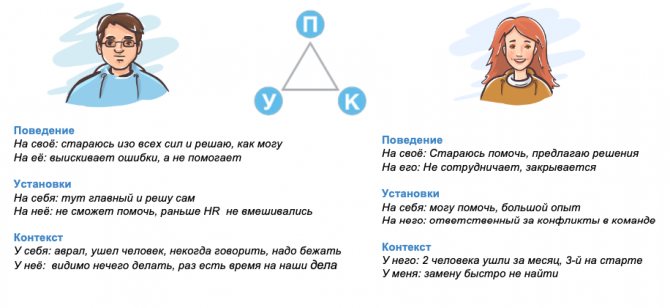business development for executives
30.11.2021
Author: Academy-of-capital.ru
Add a comment
Rating:
| (No votes) |
From this material you will learn:
- The essence of the conflict management process
- 5 main reasons for conflicts in an organization
- 4 types of possible conflicts
- 5 styles of behavior of parties in a conflict situation
- 5 groups of management conflict management methods
- 4 main principles of successful conflict resolution
- 7 stages of conflict management
- 5 Tips for Conflict Management
- Necessary skills for successful problem solving
Skillful conflict management in an organization allows you to avoid many problems, both personal and general. This skill does not allow the company’s work to stall, and sometimes even significantly spurs the enthusiasm of employees, that is, it serves as a kind of engine of progress.
However, all this is possible only if you understand well what exactly should be done in a particular case. That is, managers must be well versed in theory: know the basic principles of successful conflict resolution, choose methods appropriate to the situation, and have certain personal qualities.
The essence of the conflict management process
Conflict management is an activity aimed at resolving disputes and eliminating differences between parties defending different points of view. The ultimate goal of such activity is the complete resolution of the conflict, that is, the achievement of mutual agreement. Each party should come out of the situation with a feeling of satisfaction and benefit that they received for themselves.
Conflicts can have different types of functionality. These can be heated but constructive dialogues between subjects, contributing to the solution of important social problems, or destructive disputes leading to the destruction of the social system. Therefore, the dynamics of conflicts are usually regulated by subjects of social management, whose actions are determined based on their own interests.
The main goal of conflict management is to prevent destructive situations.
It is important to see the possibilities of conflict management in an organization from the point of view of internal and external positions. The internal position involves managing the behavior of the person involved in the conflict and is based on the possibility of using psychological approaches. The external position represents the organizational and technological aspect of this process, in which both the manager responsible for the implementation of the goals and the employee performing official duties are considered as subjects of management.
A conflict is a signal of a failure that arose in the communication process. Poor conflict management can make the situation worse. Therefore, it is necessary to defuse it as quickly as possible, trying to avoid mistakes and miscalculations that could cause an increase in tension.
Conflict in a team: how to reduce losses, benefit and stay alive. Part 1
Hello, Habr!
My name is Tatyana, I am Team Coach R&D at Plesk, and we resolve most of the conflict situations in teams together with team leads.
Conflicts arise from time to time even in the most cohesive teams. And if they are not resolved naturally and constructively, they create costs, reduce the productivity of the entire team, demotivate and destroy trust.
Over the past few years, our approach to conflict management has changed significantly. We have learned to solve them faster, more efficiently, and with fewer losses. But even now our team is only halfway there.
At TeamLead Conf 2022, I shared the obstacles we overcame, the mistakes we made, the approach we developed, and the recipes that worked. Unexpectedly, the report made it to the TOP-3. You can combine reading and listening to a video of the speech.
There was a lot of content, so colleagues from Ontiko suggested breaking it into parts and writing two articles based on the report. Therefore, I am glad to share today the first story about our approach to conflict resolution (more theory), and an article with specific cases (practice) will be published in a week.
The story turned out to be voluminous, so here is a summary.
- Introduction
- What is conflict?
- Where can conflict arise in a team?
- Structure of the conflict
Finding participants, their points of view and context
- We identify positions, interests and formulate the problem
- How to find interests hidden behind a position?
- Stages of conflict
- Interaction styles in conflict
Introduction
The topic of conflicts is raised from time to time at conferences and in articles on Habré. But, in my opinion, most often we are talking about specific communication techniques and ways of working with manipulation. That is, reactive actions are considered “in the moment,” in the midst of a conflict confrontation.
But think about it, how often do we, at the time of a conflict that occurs on emotions, remember those 33 techniques that we read about in a book and act according to the instructions? Most likely rare. And our first reaction to a conflicting stimulus is not always thought out, often emotional. We are usually unhappy with the result of such a reaction.
At the same time, when faced with a more familiar technical problem, the first thing we usually do is evaluate it, decompose it, examine it from different angles, validate the data, reduce the degree of uncertainty, and only then begin to solve it. You can work with conflicts in the same way.
I propose to focus on diagnosing the conflict. My hypothesis: if we learn to quickly and accurately diagnose a conflict, we will be able to quickly, accurately and cheaply choose the right way to manage it.
I suggest that you first get under the hood of the conflict and see what it consists of. Next, look at what laws the conflict develops dynamically. As a result, we will put the steps to manage conflict into a small algorithm.
Logic of working with conflict / Contents of the report and two articles
Let's check the cards for the main characters: who is the team lead?
Historically, our team leader is, first of all, an experienced engineer with a balance of hard and soft skills, who had the authority of a cool engineer, but became interested in strategy, people and became a manager. Perhaps you recognize yourself in this portrait.
Portrait of a Plesk team leader
What is conflict?
Before reading the next block, try to take a moment’s pause and answer the question: what is conflict for me? What associations does this word evoke in me? What does it sound like, what does it look like?
And to remember whether we are ready to openly discuss conflicts to which we were directly related, let’s look at a situation in which everyone probably found themselves.
Interview. For the position of team lead. Let's imagine, for example, that an HR manager tests your conflict management skills and asks how you resolved conflicts in your team. You answer: “Well, what conflicts! I am a completely non-conflict person!”
Dialogue about conflicts in interviews
Question: why did you choose the tactic of not talking about conflicts in the team that you probably had?
Perhaps because when you heard the word “conflict” your imagination pictured failures, and you didn’t want to associate your reputation with them in an interview? Or maybe you didn’t want to talk about the fact that in difficult situations you made decisions almost randomly?
One way or another, in this example, the interlocutors look at the fact of the presence of conflicts in experience differently. The team lead, who decided not to talk about ambiguous cases, did not expect that for HR a person without experience in solving problems is a pig in a poke, and a candidate with experience of failures from which the right conclusions were drawn is a godsend.
Today we’ll talk about different attitudes to conflict. In our team, the attitude towards him has changed evolutionarily. When we started to sort out complex conflict situations with our team leads, we noticed that most of them were associated with losses, burnout, stress, loss of trust, powerlessness and putting out fires.
In general, the conflict was inevitably associated with negative things, which are sometimes easier to sweep under the rug, because... What to do with them is completely unclear. It was also possible to pretend that nothing was happening, or to nip the conflict in the bud - especially since the team lead had administrative leverage. I will not hide that we had similar stories, but gradually we began to admit that such an attitude towards the conflict costs us dearly.
Let's get a little synchronized in terms of concepts. You've probably already thought about your associations and terms that are familiar to you. I propose today that by conflict we understand any situation based on a contradiction (and often more than one) born at the intersection of the interests of several parties.
Where can conflict arise in a team?
In fact, a conflict can arise at any stage of the management cycle: when you plan tasks, set them, control their implementation, motivate people, give them feedback.
Conflicts at any stage of the management cycle
There are many reasons for their typology, let’s take a simple one - based on the composition of the participants: interpersonal, inter-team, conflicts between roles and systems.
Types of conflicts by composition of participants
Surely, you have come across all the named types. But most often we are disturbed and drained of strength by interpersonal conflicts in which something personal and important is affected. What we are doing right now. Therefore, we will mainly analyze them further.
Structure of the conflict
Now let's figure out what the conflict consists of.
Finding participants, their points of view and context
The first step is to understand who is actually involved in the conflict. If there are few participants, they are in an open constructive dialogue, we can quickly understand the problem and offer a solution.
But in interpersonal conflicts, the interests of even two participants are often not obvious; hurt feelings prevent an open dialogue. And if the team has not yet developed a clear culture of conflict resolution, the team leader will have to try hard to understand which problem is really worth solving and which is false or secondary.
The situation is complicated by the fact that team conflicts often involve not two participants, but several, and not all of them are obvious. The composition can be varied - support groups, coalitions, other “onlookers” participants. Everyone is vocal about their point of view, but the “thought leaders” of a conflict are usually not those who speak loudest, but those in the shadows. Identifying them is not always easy, but it is important - they are the ones you need to talk to first.
What is worth talking about?
When analyzing conflicts in a team, we often noticed that both employees and ourselves often talk about the same fact, but put completely different meanings into the words. This is a trap that is important to reflect on in time.
Everything becomes easier if you learn to align the context : understand what fact a person is talking about, what really stands behind it, what goals and interests he pursues, what emotions he experiences. It is important to learn to separate one from the other, recognize and discuss what is necessary. When such a skill is developed, arguing becomes much easier.
We separate the fact -> its interpretation -> emotions -> compare the cards
To help separate the flies from the cutlets, there is a tool called the Triangle Criminal Procedure Code - a method for diagnosing the structure of a conflict, proposed by conflictologist Christopher Mitchell. The method helps to look at the situation from the point of view of each side.
If each participant in the conflict can formulate his own view of himself and his partner and tries to formulate the same for the second participant in the conflict, this can become an important stage in the dialogue.
It is assumed that each party will formulate a view on specific actions (their own and the opponent’s), reflect on existing attitudes towards themselves and their partner, and describe their perception of the context - the objective circumstances in which they and the opponent find themselves.
The point of view can be “read” from another, it can be asked about directly, it can be clarified and recorded in writing on the “conflict map”. Validated data about each other is a reason for synchronization, increasing transparency, understanding the essence of the conflict and the problems that require solutions.

Points of view of the parties according to the “Triangle of Criminal Procedure Code” method
It is also extremely important for the team to be able to synchronize on values. This is a guarantee that even if we initially argue at the level of different meanings, we will be able to solve the problem on its merits and, which is very important in team conflicts, maintain (or even strengthen) relationships.
A simple example of my own mistake and misunderstanding in online dialogue. The department had a case of non-standard internal rotation for a key position, and something went wrong.
In my opinion, the team leads did not talk quite correctly with the person they wanted to offer to radically change their role and team. And, cutting corners during a call in Google Meet, I allowed myself to give a rather careless assessment of the actions of one of the guys: “Vasya, why did you shift responsibility for communication?” And the always very diplomatic Vasya very quickly reacted and retorted: “What kind of nonsense are you talking about? I didn’t shift any responsibility!”
Another interested participant took part in the conversation, which heightened the perception. There could have been a curtain right away, but we quickly realized that the conversation had gone in the wrong direction, returned to the facts, found out common interests and agreed to resolve the issue on the merits.
But immediately after the call, we contacted the team lead, apologized to each other for the wording, and once again explained the nature of the trigger. And this is a very cool feeling of shoulder, like-mindedness, when in disagreements you can immediately align the context and speak frankly about perception.
values help us a lot in this : openness, safety, timeliness, non-toxicity and trust. Attunement to basic values helps to remove misunderstandings on the spot and not leave a residue.
We identify positions, interests and formulate the problem
Often in conflict we argue at the level of positions , and often they are mutually exclusive:
But behind these declarations there are most often specific interests that we do not talk about.
There are substantive interests, and there are psychological ones, which often even come to the fore.
the problem that needs to be solved most often lies
Thus, in conflict analysis, it is extremely important to learn to separate what people say from what really stands behind that statement.
Correlation of positions and interests in the conflict
It is important to consider that there is usually more than one interest behind each position.
For example, in the case of internal rotation, behind the position of transferring a specific employee to a new role, each party had a number of its own interests. The goals of all teams were constructive, but some interests overlapped.
Each team assessed its balance of resources and tasks, risks and benefits due to rotation. Therefore, a competent scenario required that all the interests and all the doubts of the teams and individual participants be clarified and brought to the negotiating table.
Important: as soon as we learn to find out what interests, needs, and values lie behind each position of the parties, we will understand that we can replace positional bargaining with substantive negotiations.
A simple everyday example. Let's imagine that two children are fighting over one orange. This is a scarce resource, both sides want to have it. What to do? You can throw away the orange, place the children in the corners. Or you can ask: “Tell me, why do you need the fruit?”
Let's hear that one child decided to bake a pie; he needed a crust and zest. And the other wanted to squeeze out fresh juice. We see that if you look _behind_ the declaration, you can invent a previously invisible, mutually beneficial option for satisfying initially mutually exclusive positions.
When the situation becomes more complicated, the same approach works.
In negotiation strategies it is also called “increasing the pie.”
Harvard scientists R. Fisher and W. Urey were the first to talk about this approach; there is an article on Habr with a synopsis of one of their famous books on this topic.
Or a real example from the life of one of our teams. Engineer Petya came to the team lead with an offer and asked to increase the salary by one and a half times, noting that otherwise he would be forced to accept the invitation of another company.
The team leader is upset, but throws up his hands, since it is not possible to resolve the issue in this way. I find out about the situation after the fact, conduct an exit interview and hear from the engineer:
– To be honest... I didn’t want to leave at all, money was just an excuse...
– ?…
– I got tired of being a developer and wanted to try myself as a devops engineer...
- Okay, why didn’t you say so directly?
- Yes, it was somehow awkward. But I was hinting! Apparently I’m not suitable...
Having found out all the details, I suggest calling the team lead and going back a step, discussing the options and finding a solution. The engineer would be happy, but by the time of the exit interview he had already given his word to the new company and became involved in new prospects.
What happened? The conversation between the team lead and Petya initially took place at the level of positions: “give me money, I won’t give you money.” At the same time, they had common interests - working in the same team, cutting their favorite product. Initially, both did not want to lose each other, but these interests were not revealed.
Both of them either did not hear each other’s silence or hints, or interpreted them incorrectly. Hidden interests remained at the level of a private position and did not turn into a neutrally formulated list of problems that could be discussed and solved:
– the possibility of changing the role in the current team – the possibility of changing the team – conditions for a salary increase – and so on.
If we evaluate the consequences, then such a mistake is expensive for the team - investing in effective communications with an existing employee is much cheaper than recruiting and immersing a new one in the project.
We had similar problems not only in situations with engineers, but also at the level of team leads. Sometimes, when inviting us to discuss contradictions in the team, we could hear the following words from the guys:
-What's the problem? I do not have problems.
– I don’t have any conflicts in my team at all. You have misunderstood it!
- Everything is calm for me. There is a problem, but I am not a psychologist for them, not their father or mother - let them resolve it themselves.
- Listen, have you even seen my schedule?
- I don’t understand, am I to blame?
Perhaps you said something similar to your leader or HR, who decided to open up a sore spot and help. Think about it, what really stands behind these formulations?
Remember, maybe in similar situations you felt the same? If so, then a great help in the conflict will be the ability to move from provocation and defense at the position level to the level of frank dialogue about your needs, concerns and resources, and by your example teach constructive dialogue to the team.
How to find interests hidden behind a position?
Of course, you can simply ask: “Petya, why do you want to leave?” And he can answer: “Yes, that’s why.” But more often than not, people do not speak directly about their own motives, especially if we are talking about difficult and significant situations for them. There are different reasons, each of which can be dealt with in its own way.
I will share the ones that I encountered most often in conflicts:
- People had different understandings of the terms/essence of the problem.
- They understood/knew the facts differently.
- Leverages and consequences were understood differently.
- They felt the distance, the lack of contact, and did not understand the goals of the interlocutor.
- They had certain role expectations (“I was waiting for you to ask in more detail”, “I was waiting for the team lead to ask”).
- They considered themselves/their interests “insignificant”, “outside the system”.
- They tried to “save face.”
- They were afraid of condemnation.
- They were afraid of disclosure.
- We were at the moment under the influence of a traumatic situation for ourselves.
- They felt meaningless, did not trust the sincere interest of the leader, and projected past experience.
- They understood etiquette and confidentiality in their own way (“it is indecent to reveal details in which management is involved”).
Above, we examined the “triangle of the Code of Criminal Procedure,” which, among other things, will help bring to the surface the hidden interests of the parties. In his book “Jedi Techniques for Constructive Communication,” Alexander Orlov also offers simple formulations in the form of questions.
If a person does not answer the direct question “Why?”, you can offer him your own solution and ask him to criticize him. It is sometimes easier for people to criticize someone else's decision than to offer your own. But the interests in such “cases on the contrary” also become clearer.
What to ask:
- Why don’t you like my version? -Which decision do you see as correct? - How do you see it? Why do you want it? - Why not"? -What exactly do you want? - How do we solve this?
Sometimes it works.
So, what we have already sorted out:
– what do we mean by conflict; – how to identify participants in the structure, their positions, interests, needs and view of the context; – why and how to agree on terms and expectations from each other; – how to formulate a non-judgmental problem for solution.
Structure of a conflict situation
Dynamics of conflict
Let's now look at how the conflict develops. This is important because the conflict, like any thriller, has its own dramaturgy. It grabs us emotionally, and when this happens, we instinctively want to fight back, attack back, defend ourselves, or hide.
If we learn to recognize conflict by “weak” signals at a stage when it has not yet entered the stage of open emotional declarations, it will be easier, more effective and cheaper to manage.
Dynamics of a conflict situation
Stages of conflict
Conflictologists identify a large number of stages of conflict. For example, the Austrian conflictologist Friedrich Glazzle in his work “Conflict Management” describes as many as 9 stages, but we will look at four main ones.
1. Pre-conflict . The first disagreements have arisen, and the parties are still trying to resolve them in a non-conflict manner. But time passes, an agreement cannot be reached, tensions grow.
2. Stage of open conflict. Escalation. With increased tension, something happens that becomes a “point of no return.” Such an incident can be a careless word or action - accidental or deliberate, provoked by one of the parties. After that everything goes to hell. It is usually extremely difficult to reach an agreement at this stage.
3 . Stage of open conflict. De-escalation. The situation reaches a certain peak, after which the tension subsides. But this does not always mean that the conflict is moving towards resolution - perhaps the parties have taken a break, are hoarding resources, looking for information, and have even lost the motive to fight. But with proper management of the situation, this may well mean that the parties have heard each other, recognized the legitimacy of demands, fears and emotions, cooled down and are looking for a solution.
4. Post-conflict . An important stage that will show how correctly everything was decided at the previous stage. It’s too early to relax, it’s important to observe. If the parties “swept the conflict under the rug” or settled it by force, but did not solve the problem in essence, then with a high degree of probability it will flare up again.
When you notice signs of conflict in your team and analyze what is happening, you can ask yourself the following questions:
- Where are we now? — What was hidden and becomes clear? — What became the incident? — How did the interaction change? — What is the forecast for the aggravation of the situation on a 10-point scale? — Is a new revolution possible?
How to recognize escalation
A little about how you can find out that the matter smells of kerosene, although no one on the team raises their voice, slams the door or defiantly leaves the chat, while the conflict is already at the escalation stage and requires active action.
You may notice that communication and relationships have changed within the team. The guys who yesterday were playing board games together and drinking beer in a bar, celebrating the release, today turned from partners into enemies. Arguments in disputes have become irrational. Trust was replaced by the expectation of a catch. The section of responsibility for the failure at the iteration turned into a sharp debriefing with shifting the blame.
Everything has become so escalated that nuances have disappeared, thinking and arguments have become black and white, and any action of the “other side” has begun to be interpreted as intentional harm and damage to oneself.
What happens at the stage of conflict escalation (open conflict)
And vice versa, if jokes and open clashes during work disputes in your team were commonplace, everyone was OK, and no one was shy about swearing when they were solving problems on the merits, but “suddenly” everyone became extremely polite and acted according to instructions, then this is more like an “Italian strike” than a sharp change in cultural code. This, however, is rather about how to identify a hidden, “cold conflict” in the active phase; this can be discussed separately.
Once you know that you are now in the escalation phase, you need to take immediate action. How can development be stopped at the escalation stage?
There are a number of techniques for direct and preventive amortization (you can read about them in the books of Mikhail Litvak, for example, in “Psychological Aikido”) and active listening techniques that will help to amortize emotions in a conflict due to the fact that they will be revealed, named, heard and recognized .
You can also use a series of questions that will help bring a person back to reality and conscious perception. If you are embroiled in conflict, it is worth asking these questions to yourself. And if you are a mediator in a conflict - to a colleague.
– What do you really want now? – What will happen if you continue to do A? – Are you ready to bear the consequences of B’s actions? – What do you think will happen if you continue to publicly discuss Vasya in the kitchen and say that his code is g*o?
Questions with a reality test and validation of consequences are often sobering and allow you to return the conversation to the subject.
Choosing a solution
When you have analyzed the conflict from different sides, you can choose a management .
- I propose that in a narrow sense, conflict management is understood as the resolution of a conflict or its episode,
- and in a broad sense, we understand conflict management as any conscious action in response to a conflict.
There are many approaches to conflict management. But since we consider conflicts in a team, we by default consider partner integrative negotiations and the win-win approach to be more effective than the win-lose approach.
Interaction styles in conflict
Positional bargaining, based on rivalry and suppression of information, may suit you once with a one-time sale of a gadget on Avito, but it will definitely come back to haunt you in a conflict with a “difficult” employee. Even after resigning, he will be a leader of opinion in circles, the reputation of which may subsequently be critically important for you.
According to famous American conflictologists Kenneth Thomas and Ralph Kilmann, 5 main styles of interaction in conflict can be distinguished. And each of them has its own advantages and limitations.
Approaches to interaction in conflict
1. Suppression . You act from a position of strength, the administrative leverage that you have, without taking into account the interests of the other side.
It happens that such tactics are appropriate - for example, in the event of a “fire”, when decisive urgent action is required and there is no time to negotiate. But after that, you definitely need to explain what happened.
2. Evasion. Sometimes you can simply walk away from a conflict, ignore it, or limit contact with the conflicting party. This may be an appropriate tactic if the gain is not comparable to the damage or the current development of the situation does not promise a gain at all. Perhaps the clash is with an equal participant, and complications in the relationship are undesirable. Perhaps you need to gain time or this conflict is not relevant to you at all now.
3. Device. This tactic can be chosen if you are ready to sacrifice your interests for the sake of the interests of another. For example, when your relationship with a person is more important than the subject of your disagreement, or the problem as a whole is not very significant for you.
4. Compromise. It implies only partial satisfaction of interests, therefore in many cases it is considered a rather unstable technique. Compromise is loved because it allows you to save relationships and not lose everything; it can be a temporary solution when suppression or cooperation is impossible or does not bring the desired effect. And they criticize the fact that if a party infringes on important points for it, the visually stable agreement will fall apart and the conflict will flare up again.
5. Collaboration. It involves a joint search for a solution that will suit everyone. Therefore, many consider it a “magic hike” that should be applied everywhere. But this is not entirely true; cooperation is a very “expensive” strategy that is not always possible. For example, you want to cooperate, but your colleague does not. It is unknown what to do about it, and there is no time to decide. There are techniques for bringing a party into integrative negotiations, but this is a separate complex topic. Therefore, an important condition for the implementation of a partnership approach will be approximately equal and voluntary desire, as well as the ability of each party to invest all resources in developing agreements.
Let's get back to practice. Many approaches from books on raising children are very similar to approaches in books for managers. Therefore, let's look at another everyday example that will seem familiar to many who work remotely.
Many approaches from books on raising children are very similar to approaches in books for managers. Therefore, let's look at another everyday example that will seem familiar to many who work remotely.
So, you are on remote mode, there is a quarantine around you, everything is closed, you are working from home, and children are running around in the background.
Let's imagine that two children are making noise while trying to share a ball.
And you have an important ZOOM call.
Gluing children to the wall with duct tape is only possible in an Internet meme.
There are three sides here: you and the children, and each has its own interests. For children - to play, for you - to have a normal meeting, and also - to teach children to respect your work space and agree with each other. Common interests are to maintain respectful relationships and atmosphere in the home.
If your call starts any minute, you only have time to put on your top, pick up the ball and close the door, offering to discuss everything later. You may decide that suppression is appropriate here.
But if there is still time before the call, you can choose a partnership approach and ask: “Tell me, what is the problem? What can we come up with so that you can agree and I can work in silence?” In this way, you demonstrate interest in what is behind the behavior of children, in a sense, you even respect this fight as a construct and teach a different approach, to talk by example.
And you don't need to be a certified coach to do this. The good news: by and large, everyone who knows how to listen, hear and ask questions is already working in the coaching approach. From this perspective, each team leader can easily be a coach and mediator in a team conflict.
Our current approach
I began the story by describing the approach to conflict as an unwanted problem that is easier to avoid and suppress. But today conflict is a normal occurrence for Plesk team leads. We accepted this not at the level of a beautiful declaration, but at the level of lived experience and conclusions drawn. Where there are people, there will always be conflicts; there is no change without clashes.
– At the heart of a conflict are usually contradictions that require resolution. Solving problems is our job.
– Conflict can be useful. So much so that it is worth learning to intervene in a conflict, sometimes it is even worth provoking it.
– Inability to negotiate, lack of time – these are bad habits or lack of skills. This can and should be changed.
How exactly did we get to this point:
– in case of disagreements, we agreed on terms, – we revised roles and expectations for each other, – we aligned contexts, – we clearly formulated positions, explained to each other what we wanted and why, – we looked for common interests and relied on them, – we gave each other feedback, if something went wrong, we stopped comparing ourselves with carrots, admitted that experiences can be different, and we are stronger together, we began to admit mistakes.
Gradually, we also built a system of internal LeadTalks, where team leads meet, exchange experiences, sort out difficult situations and look for new solutions. This happens almost every two weeks.
Long-term training of all Plesk team leads at the management school, where the guys became acquainted with the principles of the famous American psychotherapist Milton Erickson, some of which they took into their work, also helped us develop a new approach to solving difficult situations.
- Changes are inevitable . We are growing, everything will change, those who are flexible will survive.
- Everything is OK with everyone . Each author of his own decisions. This means that, a priori, all participants in the conflict are normal. And there is no need to get into a person’s head if he does not have a request for it.
- Everyone has all the resources. By default, a person has everything they want and need in order to change. If you make it clear to a person that he is not currently operating within the rules of your team, he is free to change. If he doesn’t understand how, he’ll ask you.
- The basis of everything is positive intention . This is a very important approach. It lies in the fact that every action of a person on our team is based on a positive intention. Nobody wants to write bad code and intentionally damage the release. If, for example, a mistake was sent to production, it means it was made by accident.
- And at that (and at every) moment it was the best choice a person could make.
We based our approach on 4 more principles.
1. The solution is based on diagnostics.
2. Gently towards the person, firmly towards the problem.
3. Focus on cooperation.
4. Form first, then essence.
Let me expand a little on the second principle: it means that we share our attitude towards a person and our attitude towards a problem.
A person’s behavior in a conflict at some point can be negative and even harmful in its impact on the project, result, or team. But this is an assessment of specific actions and consequences. This does not affect our attitude towards the personality of the team member himself. He remains our colleague, friend, partner and just a good person.
An example from the life of our team. Complex in emotions, delicate in ethics. We had a colleague, a very talented experienced engineer, who had been working on the team for many years. But something happened in his life, and he began to drink. This happens, this is life.
What did we do? For some time they carefully but firmly said that any manifestations of drunkenness during working hours were unacceptable and harmful, and asked to change the situation. She didn't change. And it became obvious to a large part of the team.
Some would probably break up right away. But we asked a question and heard that the employee would be glad to get all kinds of help. Then we enlisted his desire to change the situation and for almost a year we supported him in various ways: we recommended doctors, psychologists, supported him personally, and built a system of sick leave and recovery leave. They considered it important and correct.
In our opinion, without such a partnership approach to people, conflicts in a team cannot be effectively resolved. And often this choice is tactically quite expensive. Moreover, he is not even talking about some deferred strategic benefit. This is not written about in the “benefits” section on the company’s career website.
But this is a cultural code that is formed from specific decisions in difficult situations. And gradually becomes part of the team's DNA. These are the values that allow you to feel safe not only at the peak of success, but also in situations of vulnerability that are characteristic of any conflict.
And the fourth principle: “first form, then essence.” I won’t say that we follow it perfectly, but we understand the importance of wording. And if we are not satisfied with the form of communication, we first try to make it work, and only then move on to the essence of the issue.
For example, if a holiwar starts in Slack chats and gets personal, the leaders try to move the conversation in a constructive direction. Guys-engineers also learn from concrete examples, and one day they themselves take on the role of a peacemaker, facilitator and mediator, even in a “neighboring” conflict. And it’s all about common values, goals, approach and team.
In the next article, we will analyze several large cases of conflict resolution from our experience, talk about what a conflict map is, and consider a conflict management algorithm.
PS Kirill Anastasin’s memes from his https://komikaki.ru/ were used as some illustrations, many thanks to him.
The nearest Ontiko conference - Saint TeamLead Conf 2022 - will be held on September 16 and 17, 2022 at the DESIGN DISTRICT DAA in SPB. You can purchase tickets for it today.
We look forward to seeing you at the 2022 conferences!
Number of conflicting parties
- Intergroup . A confrontation between two groups, each of which includes participants in the conflict, united by some characteristic/signs.
- Interpersonal . A clash of interests between two entities or between a group of people and one entity.
- Intrapersonal . Confrontation of internal values and motives at the personal level. There are no parties, there is only one subject who is faced with the problem of choice regarding making this or that decision.
How to learn this?
Continuing the conversation about innate and acquired skills, it is important to say that from birth a person does not have any knowledge. Any information is absorbed by a person over time. Skills develop in a similar way. If a person has a predisposition to something, in our case, to function competently in conflict situations, with practice his skills will be honed and will be useful in life.
But if a person does not have such a predisposition, he has to learn solely by trial and error. But the main thing is to learn, because, as the famous proverb says: “It’s hard to learn, it’s easy to fight.” Moreover, a person has an amazing ability to learn anything, naturally, with effort. You can learn in two ways: by studying theory and applying knowledge in practice:
| 1 | Conflictology in theory is information that you can find in books, textbooks, get from other people and from other sources. |
| 2 | Conflictology in practice is the use of received information in real life. |
However, situations when a person does not go beyond theory are no exception. Yes, he has information, but it does not bring him any benefit. And this is not because the information is of poor quality or useless, but because, as a rule, he simply does not know in what direction to direct his efforts so that something starts to work out.
Taking this nuance into account, we developed our training. Its goal is not just to introduce the reader to a powerful theoretical base, but to bring to his consciousness the idea of its practical application, to teach him how to use it in his life.
Keep in mind that our conflict management training has both theoretical and practical aspects. The theoretical part will introduce you to the basics of conflict management and answer the most common questions within the framework of the topic under consideration. And the practical part contains valuable tips, tricks and methods that you will apply. Moreover, both theory and practice are supplemented with simple illustrative examples in order to eliminate the factor of misunderstanding.
Want to test your knowledge?
If you want to test your theoretical knowledge on the topic of the course and understand how suitable it is for you, you can take our test. For each question, only 1 option can be correct. After you select one of the options, the system automatically moves on to the next question.
Statistics Full screen
What is conflictology?
Conflictology is a discipline that studies the patterns of processes such as the emergence, development, resolution and completion of conflict.
One of the people who laid the foundations of the general theory of conflict was Karl Marx. He developed the doctrine of contradiction and developed a model of social change. After him, the foundations of the doctrine of conflict were formulated by the American sociologist Jonathan Turner. In addition, the American sociologist Lewis Coser and the German sociologist and philosopher Georg Simmel made a huge contribution to the development of conflictology science. If we study other sources, we can conclude that mainly sociologists, psychologists and political scientists took part in the development of conflictology in general, both in our country and abroad.
However, several significant circumstances allow us to draw a line between domestic and foreign conflictology:
- Abroad, attempts to create a theory of conflict were made back in the 19th century.
- Abroad, more approaches are used to study conflicts
- Abroad, conflictology is taught at the largest universities
- Bachelor's and Master's degrees in conflict management are available abroad
- Abroad, conflictology is a science, mainly of an applied nature.
As for domestic conflictology, the first publications on this topic appeared only in the 20s of the 20th century (the first work dates back to 1924; its authors are M. I. Mogilevsky and P. O. Griffin). In these works, the problem of conflicts was first identified as an independent one, and the term “conflict” already appears in the titles of the works themselves. And as a separate science, conflictology took shape in Russia in the early 90s. At present, Russian researchers are paying more and more attention to conflictology and the problem of conflict.
Now the time has come to say a few words about the central concept of conflictology - conflict.
Conflict in its general understanding is the most acute way to resolve contradictions in views, goals, and interests that arise during social interaction. The essence of the conflict lies in the confrontation between its participants, accompanied by negative emotions. Often this confrontation goes beyond social norms and rules.
But conflictology distinguishes between two main types of conflicts - social conflict and intrapersonal conflict.
Social conflict is the most acute way of developing and resolving contradictions that are important for people that arise during their interaction. The essence of such a conflict is similar to the essence expressed in the above definition of conflict.
Intrapersonal conflict is an acute negative experience caused by a long-term struggle of the internal psychological structures of the individual, reflecting the contradictory connections of a person with the social environment, and also complicating and delaying decision-making.
The ability to recognize and prevent the occurrence of conflict, as well as to manage and neutralize it, opens up enormous opportunities for a person. It allows any person not only to effectively resolve problematic situations and successfully get out of difficult situations associated with conflicts, but also to anticipate potentially dangerous situations and take appropriate actions to suppress them.
By and large, such a skill can make a person’s life more harmonious, painted in brighter colors and filled with predominantly positive emotions. Of course, we should not idealize, but if all people on the planet applied the principles of effective conflict prevention and resolution in their lives, then, for sure, there would be less disagreement, hatred, and wars in the world.
Here is a simple example at the everyday level: if, for example, two family members do not know conflict resolution skills, then if a dispute, misunderstanding, or disagreement arises, the situation with a high degree of probability can develop into a serious family scandal, the result of which can simply be negative emotions of people towards to each other, and complete discord and even a break in family relationships.
But when at least one person has the skills of conflict management, he is able, firstly, to prevent the situation from getting out of control and leading to devastating consequences, and secondly, to make sure that it does not appear at all, because he can recognize it before it even appears. And this can be applied not only to the area of family relationships, but also to any other.
conclusions
Learning to manage conflict is not easy, but it is a most valuable skill for a company leader. Firstly, it helps to establish relationships between people, and secondly, it serves as a good engine of progress.
Please note that it is unwise to be afraid of conflict situations or avoid them. This makes employees “psychological hostages of the situation”, unable to act quickly and correctly. But trying to prevent by introducing an organizational chart, constantly working with staff (holding regular meetings, carrying out written communications to prevent distortions) is quite effective.
- Theoretical concepts of European design in the process of its formation and development in the first half of the twentieth century.
- Formation of the personality of a criminal (The concept of the personality of a criminal)
- Project management in e-commerce systems..
- PROJECT MANAGEMENT FUNCTIONS (Project Management. Fundamentals)
- The concept and scope of document flow in an organization (Unified documents)
- Main macroeconomic problems and their features in the Russian economy
- Organizational behavior in a cross-national context (commons and differences between countries).
- Types of wear and tear (Determination of the average percentage of wear and tear of comparable buildings for its transfer to the valuation object.)
- Level of development of social intelligence in people of different age groups
- Concept and characteristics of production organizations.
- Methodological aspects of assessing intangible assets and IP objects.
- Modern information projects and their features
We decide and manage
In the event that conflicts that arise are not managed or managed ineffectively, the consequences will be dysfunctional, interfering with the achievement of the organization's goals. These include an increase in personnel turnover, a decrease in productivity, a shift in goals and emphasis - the main thing is winning the confrontation, and not resolving production issues.
All methods of managing conflicts that have arisen can be grouped into two blocks: structural methods and interpersonal methods of resolution.
Regardless of the method chosen, the conflict that has arisen must be analyzed to identify the real reasons, which may have nothing to do with what caused the controversial situation, and only then take adequate measures.
INTRODUCTION
Conflict is an integral element of the functioning of any society.
In modern society, in conditions when the “speed of life” increases every day, when stress is familiar to almost everyone firsthand, when everyone strives for something and is afraid of something, the problems posed by conflictology - prevention, analysis, ending conflicts - have become especially relevant. These problems are relevant, first of all, because conflicts can be present in any sphere of society, and a conflict left to its own devices can lead to undesirable consequences, both for individuals and for society.
The object of this course work is conflict.
The subject is conflict management.
The purpose of the course work is to identify methods and means of conflict management.
Coursework objectives:
1. consider the essence and structure of the conflict;
2. determine the functions of the conflict;
3. highlight the essence of the concept of conflict management;
4. consider methods, styles and models of conflict resolution and regulation, as well as features of prevention and stimulation.
How to take classes?
As has already been noted more than once, the materials of our conflict management training are maximally adapted for practical use, and for use by absolutely any person. But in no case should we forget that the decisive factor here is not the study of the material, but its practical use. Reading, studying, knowing a lot of useful and interesting things is, of course, good. But if knowledge that can be applied in life is not applied, its price will be low, because they will not bring you any benefit. Keep this in mind.
You can study each of the lessons step by step. As an example, here is a simple algorithm (but you can develop your own):
| 1 | Day one – studying the material. |
| 2 | Day two – re-studying the material to consolidate. |
| 3 | Day three – applying the acquired knowledge in practice. |
| 4 | Day four – summing up the application of the material from the lesson learned. |
| 5 | Days five, six and seven – rest. |
Thus, it will take you a little more than a month to study this training. If this period seems too long for you, make your own schedule and study/practice, for example, not one lesson a week, but two. Find the option that is most comfortable for you.
I would also like to say that you need to not just apply a skill once, even successfully, but gradually and purposefully hone it in order to introduce it into the arsenal of actions that are familiar to you. Try to form a healthy habit (according to some studies, this takes 21 days).
During the learning process, use all kinds of auxiliary materials - a notebook, diary, organizer, computer or gadget. For example, set a beep in your smartphone's task scheduler at your scheduled study time to remind you that it's time to start studying. Or make a short note in a notebook every time you behaved effectively or ineffectively in a conflict situation. You can come up with anything - the main thing is that it is for your benefit.








